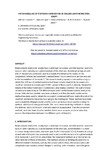Mostrar o rexistro simple do ítem
Metamodelling of stiffness matrices for 2D welded asymmetric steel joints
| dc.contributor.author | Loureiro, Alfonso | |
| dc.contributor.author | López, Manuel | |
| dc.contributor.author | Reinosa, José Manuel | |
| dc.contributor.author | Gutiérrez, Ruth | |
| dc.contributor.author | Bayo, Eduardo | |
| dc.date.accessioned | 2024-02-07T17:12:56Z | |
| dc.date.available | 2024-02-07T17:12:56Z | |
| dc.date.issued | 2019-08-02 | |
| dc.identifier.citation | A. Loureiro, M. Lopez, J.M. Reinosa, R. Gutierrez, E. Bayo, Metamodelling of stiffness matrices for 2D welded asymmetric steel joints, Journal of Constructional Steel Research 162 (2019) 105703. https://doi.org/10.1016/j.jcsr.2019.105703. | es_ES |
| dc.identifier.issn | 1873-5983 | |
| dc.identifier.uri | http://hdl.handle.net/2183/35483 | |
| dc.description | Manuscrito aceptado | es_ES |
| dc.description.abstract | [Abstract]: Beam-column steel joints usually have a semi-rigid behaviour, and this must be taken into account when carrying out a global analysis of the structure. Rotational springs at each side of the joint are commonly used to simulate this behaviour by means of the component method, but asymmetric welded beam-column steel joints are not included in the formulations of Eurocode 3. This research work proposes a new methodology to obtain the stiffness of welded asymmetrical beam-column steel joints, by means of a cruciform element of 4 nodes and 12 DOF, whose stiffness matrix is directly obtained by means of the meta-modelling of its elements using Kriging's method. The authors have carried out a wide study of 754 different asymmetric welded beam-column steel joints, whose finite element models have been analysed, and then the static condensation method has been used to obtain the equivalent condensed stiffness matrix (Kcond) of the cruciform element for the joints belonging to the training set. These matrices have been used to build the Kriging's model, and the rest of joints have been used for testing the method, which yields very good results. The use of meta-modelling methods to obtain the stiffness matrix of the joint is not only easier in its application than the component method, but it also leads to a formulation that is more accurate, and also takes into account the interactions between the different parts of the joint. | es_ES |
| dc.description.sponsorship | The financial support provided by the Spanish Ministerio de Economía y Competitividad and Fondo Europeo de Desarrollo Regional under contract BIA2016-80358-C2-2-P and BIA2016-80358-C2-1-P MINECO/FEDER UE is gratefully acknowledged. | es_ES |
| dc.language.iso | eng | es_ES |
| dc.publisher | Elsevier | es_ES |
| dc.relation | info:eu-repo/grantAgreement/MINECO/Plan Estatal de Investigación Científica y Técnica y de Innovación 2013-2016/BIA2016-80358-C2-2-P/ES/NUEVA METODOLOGÍA PARA LA CARACTERIZACIÓN DIRECTA Y AUTOMÁTICA DE UNIONES 2D VIGA-PILAR EMN ACERO MEDIANTE METAMODELOS ESPECIALIZADOS EN MODOS DE DEFORMACIÓN | es_ES |
| dc.relation | info:eu-repo/grantAgreement/MINECO/Plan Estatal de Investigación Científica y Técnica y de Innovación 2013-2016/BIA2016-80358-C2-1-P/ES/NUEVA METODOLOGÍA PARA LA CARACTERIZACIÓN DIRECTA Y AUTOMÁTICA DE UNIONES 2D VIGA-PILAR EMN ACERO MEDIANTE METAMODELOS ESPECIALIZADOS EN MODOS DE DEFORMACIÓN | es_ES |
| dc.relation.uri | https://doi.org/10.1016/j.jcsr.2019.105703 | es_ES |
| dc.rights | CC BY-NC-ND 4.0 https://creativecommons.org/licenses/by-nc-nd/4.0/deed.es | es_ES |
| dc.rights.uri | http://creativecommons.org/licenses/by-nc-nd/3.0/es/ | * |
| dc.subject | Steel Joints | es_ES |
| dc.title | Metamodelling of stiffness matrices for 2D welded asymmetric steel joints | es_ES |
| dc.type | info:eu-repo/semantics/article | es_ES |
| dc.rights.access | info:eu-repo/semantics/openAccess | es_ES |
| UDC.journalTitle | Journal of Constructional Steel Research | es_ES |
| UDC.volume | 162 | es_ES |
| dc.identifier.doi | https://doi.org/10.1016/j.jcsr.2019.105703 |






